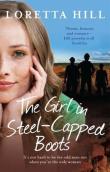AustLit
Latest Issues
AbstractHistoryArchive Description
'"Let me burst your city bubble for you. This is the Pilbara. And it's the Pilbara that makes the rules . . ."
'Lena Todd is a city girl who thrives on cocktails and cappuccinos. So when her boss announces he's sending her to the outback to join a construction team, her world is turned upside down.
'Lena's new accommodation will be an aluminium box called a dongar.
'Her new social network: 350 men.
'Her daily foot attire: steel-capped boots.
'Unfortunately, Lena can't refuse. Mistakes of the past are choking her confidence. She needs to do something to right those wrongs and prove herself. Going into a remote community might just be the place to do that, if only tall, dark and obnoxious Dan didn't seem so determined to stand in her way ...' (From the publisher's website.)
Notes
-
Dedication:
For the real Lena,
My beautiful sister and successful engineer.
When we were younger, I wrote stories to make you laugh.
Nothing much has changed.
Publication Details of Only Known VersionEarliest 2 Known Versions of
Other Formats
- Braille.
- Dyslexic edition.
- Large print.
- Sound recording.
Works about this Work
-
From Polite Society to the Pilbara : The Ingénue Abroad in Evelina and The Girl in Steel-Capped Boots
2018
single work
criticism
— Appears in: Outskirts : Feminisms along the Edge , May no. 38 2018;'The romance novel—persistently at once one of the most popularly successful genres from the eighteenth century to today, and one of the least critically respected—demonstrates surprising consistencies, and a habitual attention to gender politics that reflect the gendered assumptions and aspirations of the societies out of which it emerges. This paper explores the commonalities between two novels that, despite being produced in different times and places, nevertheless when read together share distinct concerns and tropes, often to a surprising extent. By reading Frances Burney’s Evelina (1778) and Loretta Hill’s The Girl in Steel-Capped Boots (2012), and paying close attention to their similarities and differences, this paper demonstrates continuities of convention over more than two centuries. Both novels take young, inexperienced women for their heroines, and through them introduce their readers to daily life in specific, closed communities: respectively, fashionable London of the late-eighteenth-century “Season”, and the fly-in, fly-out mining society of the West Australian Pilbara region. In this study of two novels, one published in Georgian England, and the other in early twenty-first-century Australia, it is possible to recognise the ways in which such fictions are capable of idealising, reproducing and reinforcing gendered stereotypes, and at the same time of revealing the oppressive effects of such stereotypes on the imagined lives of men and women.' (Introduction)
-
Loretta Hill – Author Interview
2013
single work
interview
— Appears in: The Australian Literature Review , February 2013; -
Fiction
2012
single work
review
— Appears in: The West Australian , 11 February 2012; (p. 21)
— Review of The Girl in Steel-Capped Boots 2012 single work novel -
Off the Shelf : Fiction
2012
single work
review
— Appears in: The Saturday Age , 11 February 2012; (p. 31)
— Review of The Girl in Steel-Capped Boots 2012 single work novel
-
Off the Shelf : Fiction
2012
single work
review
— Appears in: The Saturday Age , 11 February 2012; (p. 31)
— Review of The Girl in Steel-Capped Boots 2012 single work novel -
Fiction
2012
single work
review
— Appears in: The West Australian , 11 February 2012; (p. 21)
— Review of The Girl in Steel-Capped Boots 2012 single work novel -
Loretta Hill – Author Interview
2013
single work
interview
— Appears in: The Australian Literature Review , February 2013; -
From Polite Society to the Pilbara : The Ingénue Abroad in Evelina and The Girl in Steel-Capped Boots
2018
single work
criticism
— Appears in: Outskirts : Feminisms along the Edge , May no. 38 2018;'The romance novel—persistently at once one of the most popularly successful genres from the eighteenth century to today, and one of the least critically respected—demonstrates surprising consistencies, and a habitual attention to gender politics that reflect the gendered assumptions and aspirations of the societies out of which it emerges. This paper explores the commonalities between two novels that, despite being produced in different times and places, nevertheless when read together share distinct concerns and tropes, often to a surprising extent. By reading Frances Burney’s Evelina (1778) and Loretta Hill’s The Girl in Steel-Capped Boots (2012), and paying close attention to their similarities and differences, this paper demonstrates continuities of convention over more than two centuries. Both novels take young, inexperienced women for their heroines, and through them introduce their readers to daily life in specific, closed communities: respectively, fashionable London of the late-eighteenth-century “Season”, and the fly-in, fly-out mining society of the West Australian Pilbara region. In this study of two novels, one published in Georgian England, and the other in early twenty-first-century Australia, it is possible to recognise the ways in which such fictions are capable of idealising, reproducing and reinforcing gendered stereotypes, and at the same time of revealing the oppressive effects of such stereotypes on the imagined lives of men and women.' (Introduction)
Awards
- Pilbara area, North Western Australia, Western Australia,
- 2000-2099





